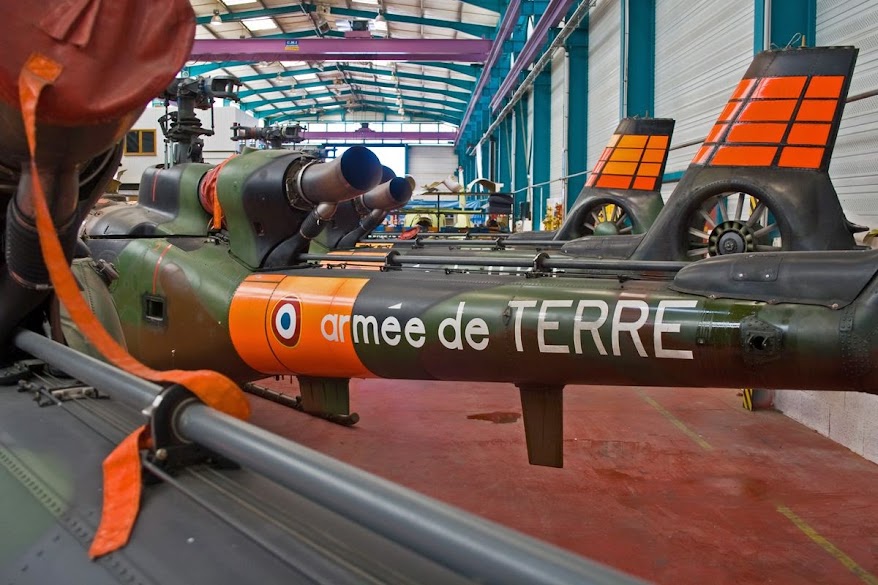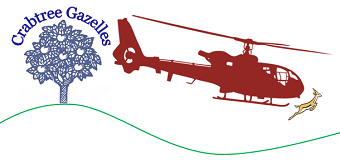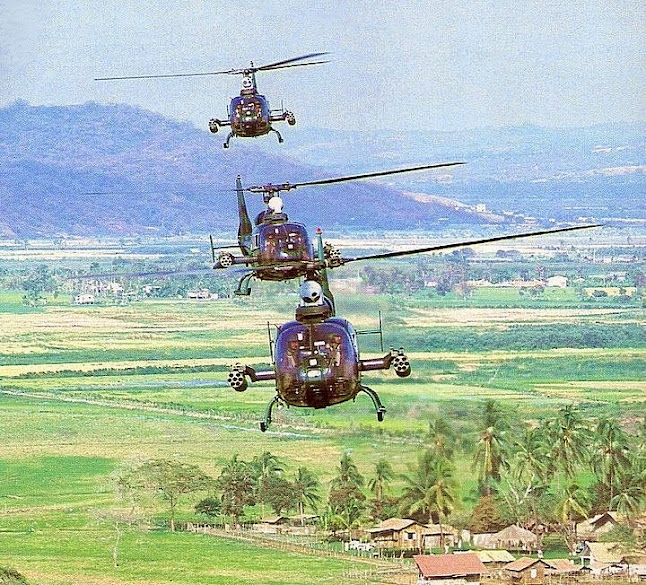Announcement
Collapse
No announcement yet.
Shrieking Gazelles
Collapse
This topic is closed.
X
X
-

A Visit to Aerotec in Valence
http://airheadsfly.com/2014/10/01/ma...he-gazelle/
It’s a sunny Monday morning. The office of Aerotec Group at Valence-Chabeuil Airport in southern France awakes after a two week summer holiday. However, in the maintenance hangar dedicated technicians have been working continuously to overhaul four Gazelle helicopters for a small southern European air force. Aerotec Group is dedicated to maintenance, repair, overhaul (MRO) and upgrade of Gazelles. Another core activity, and also the origin of this company, is all about Night Vision Goggle (NVG), compatible LED lightings and the optronics of the NVGs itself. Enough reason for Airheadsfly.com to shine a light on this company.
It all began when Paul Rossini, a former flight test engineer at GAMSTAT (the French Army helicopter test unit), with a lot of NVG experience, decided to start Aerotec Group (ATG). After developing NVG compatible cockpit lighting, they developed highly advanced NVG’s themselves. ATG has its own specialized optronics laboratory, and they now make NVG compatible lightings for different types of aircraft, helicopters, armoured vehicles and ships. Many have NATO reference codes, showing the high standard of quality of the ATG products. The latest additions are NVG compatible landing beacons, which already made its operational debut in Afghanistan in the hands of the French Army Light Aviation (ALAT). ATG also developed a night vision capability kit for the French special forces. This mobile kit enables the French Special Forces to change a standard French Air force Lockheed C-130 Hercules transport aircraf into a NVG capable aircraft for special operations. It only takes two hours for two technicians. After the mission they transfer the C-130 back for normal use.
Gazelle Overhaul and Upgrading
In ATG’s maintenance hangar at the other side of Valence-Chabeuil airport, overhaul and upgrading is done on mostly Aérospatiale Gazelle helicopters. Starting with overhauling Alouette 3 helos, in 2007-2008 an agreement was signed with Eurocopter, now known as Airbus Helicopters (Aérospatiale became part of Eurocopter first). Through this agreement, ATG became the only recognized French company for overhaul of this type of helicopter. Combined with their integrated engineering and design department, this gave ATG the opportunity to offer countries a broad range of options to overhaul and upgrade their Gazelle fleet. This also includes complete airframe overhaul, engine inspections and repairs, but also integration of the most advanced equipment such as FLIR camera, glass cockpit and modern weapon systems. Even training of pilot instructors or technicians is done, at ATG or on site.
Upgrade
The French contracted ATG to upgrade former ALAT Gazelles to the specifications of foreign military forces. These upgrades will get the maximum out of the helicopter. First customer was the Tunisian air force, who agreed with to purchase five Gazelles. These were completely overhauled and modernized, including test flights before delivery. ATG also provided NVG flight training to the Tunisian air force pilots. Other foreign customers include the air forces of Iraq (six Gazelles), and Niger (three Gazelles). Overhaul of four Gazelle helicopters for a small southern European country, will finish early 2015. During the Airheadsfly.com visit to ATG, some 6 other Gazelle airframes (all former ALAT) were seen in the overhaul facility.
The Overhaul Procedure
The Gazelle helicopter will be operational within the ALAT until 2030 at the latest. “It’s an easy helicopter, because it’s an old type”, says Joffray Sophys, Chief of Avionics at the ATG workshop. He continues working with a smile on his face. Joffray has been an avionics engineer with the ALAT for 16 years after which he spent two years at Eurocopter, before moving to ATG six years ago.
“Complete overhaul of a Gazelle normally should take about three to four months”, says Joffray, “but because some spare parts have delays in delivery time, we take eight months”. That’s the reason why ATG decided to stock some spare parts themselves. Joffray explains there are eight stages when talking about a complete overhaul at ATG:- Step 1: Stripping the whole aircraft, and checking every part of it. This takes three to four weeks
- Step 2: A report has to be made about the status of the aircraft. This will take one week. The report is used to see if the required work fits into the agreement, or whether additional work must be done
- Step 3: Fitting the avionics planning into the mechanical planning. This requires good negotiations between the mechanic, who is the project leader, and the avionics specialist
- Step 4: Start working
- Step 5: After work has been completed, every (avionics) parts is checked, piece by piece
- Step 6: Ground testing with the engine running
- Step 7: Basic test flight (15 minutes) with only a test pilot on board, for flight safety
- Step 8: Regular test flights, which also including a mechanic (one to check the rotor blades, one flight to check mechanical parts, one for radio navigation and one auto compass flight)
Photos from the Aerotec visit (all photos by Dennis Spronk):

The Chief of Avionics of the Aerotec Group inspects a Gazelle helicopter

The Aerotec Group hangar: On the left a Gazelle is being overhauled for a small Southern European country while on the right a number of former ALAT Gazelles are waiting to be sold to foreign military forces

Some Armée de Terre Gazelles are also serviced at Aerotec

Astazou IIIC engines are checked and made serviceable

Even the small Gazelle has a lot of wiring which has to be thoroughly inspected and tested

This Gazelle is being fully overhauled be Aerotec

Armée de Terre Gazelles waiting to be bought by foreign military customers
http://www.aerotecgroup.com/copyright.html
- 1 like
Comment
-
I am sure it would be possible to arrange a visit for you to Aerotec!
I wonder if they also service civilian Gazelles? Its nice to see the aircraft being fully stripped down .. especially to expose (and treat) any corrosion and or any of the other things which frequently appear when you properly strip down a fuselage.
Regarding G-BAGJ (seen in the photo in post #602 flying over the British Parliament) .. the information I have is saying the the photo (below) is of the same aircraft 'stored' in 2011. Are you (or any of your Gazelle contacts) able to confirm this. Also do you know where the location of this photo may be?

G-BAGJ (later to become G-SFTA) 'somewhere' in 2011
Comment
-
From your lips to God's ears.Originally posted by Savoia View PostI am sure it would be possible to arrange a visit for you to Aerotec!
Yes, it was taken at the North East Aircraft Museum in the UK.Originally posted by Savoia View PostAre you (or any of your Gazelle contacts) able to confirm this. Also do you know where the location of this photo may be?
Comment
-
Grazie Zis!
Having put my 'thinking cap' on I now recall that we discussed this craft on page 9. One has to admit that one is getting older I suppose!
Regarding G-BAGJ, she had two sister ships .. G-BAGK and G-BAGL. My godfather (as mentioned previously) flew G-BAGK a handful of times (see page 4) but G-BAGL was also used as a Westland demonstration/liaison aircraft for a number of years:

Westland Gazelle SA341G (cn 1067) G-BAGL as seen attending the Badminton Horse Trials in Gloucestershire c. 1980 (Photo: Stuart Mitchell)
Comment
-
The Huey is of course another great helicopter! In terms of the noise she makes .. just spectacular .. along with the Bell 222 and the Chinook!

US helicopter display pilot Chuck Aaron flying an American Gaz. Photo by Charles Aaron (his son) who is also a helicopter pilot

Charles Aaron (Chuck's son) with the Gaz

The California-based SA341F2 flown by the Aarons

The craft's hangar
Comment
-

She is now one of the Crabtree Gazelles (as in those based at Crabtree Farm near York in England) .. and who's owner is (as far as I understand it) known to both you and XB .. and who we would love to see on Avia!Originally posted by Zishelix View PostI wonder where is G-LOYD now. I haven't seen her since 2010.
The latest take on RA-05703:

SA341B Westland Gazelle RA-05703 as seen in Severka, Russia on 13th September 2014 (Photo: Maxim Stankevich)
Formerly G-CDXE (also a Crabtree Gaz) and before that Army Air Corps XZ299.
Here .. G-CDXE still in her Army paint:
Comment
-
Thanks for info.Originally posted by Savoia View PostShe is now one of the Crabtree Gazelles... Let's hope her present owner will post some current photos!
Let's hope her present owner will post some current photos! 
Comment
-

Gazelles Going To Libya
http://www.3news.co.nz/world/france-...bya-2011052410France and Britain will deploy attack helicopters in Libya as soon as possible, the French defence minister said Monday - a move that would allow their pilots more precision but also expose them to greater risk.
Gerard Longuet said the helicopters would be used to target military equipment such as Libyan tanker and ammunition trucks in crowded urban areas while causing fewer civilian casualties.
Longuet said he discussed the plan with British military officials and they were "exactly on the same wavelength".

France - sending Gazelles to Libya
The use of attack helicopters would appear to mark a new strategy for NATO, which has relied on strikes by fighter planes and seen that result in a stalemate on the ground. Nimble, low-flying helicopters have much more leeway to pick targets with precision than high-flying jets. But they also are much more vulnerable to ground fire. The alliance has had no military deaths since it first started enforcing a no-fly zone on March 31.
Longuet said France would essentially use Gazelle helicopters, which have been around for some 40 years. "It is an old machine but fully adapted to the situation," said Longuet. France also can use the Tigre, a modern helicopter gunship.
In airstrikes using fighter planes, the alliance fears collateral damage can be too great against a foe that can hide in urban areas or mix up with civilian traffic. "We had to give ourselves the means to strike without hitting civilians," Longuet said.
NATO is operating under a UN mandate that authorises the use of force - but not ground troops - to protect Libyan civilians. Forces loyal to Libyan leader Moammar Gadhafi have been responsible for attacks on civilians, and he has shown no inclination to cede power. Longuet and French Foreign Minister Alain Juppe said the use of the military attack helicopters would fall within the UN mandate.
A French military spokesman said Sunday a French amphibious assault ship, Le Tonnerre, had sailed from Toulon, France, last week. The French daily newspaper Le Figaro reported Sunday that the Tonnerre was carrying 12 military helicopters and sailing for the Libyan coast. Longuet would not confirm the number of choppers on board.
A NATO spokesman in Naples said Monday that the alliance is "aware the French government has an additional ship operating in the area" and that it is under French command not NATO's.
The spokesman said he could not say whether that would remain the case. He spoke on condition of anonymity in keeping with NATO regulations.
Longuet said France could strike as soon as "there is a target that merits it. We don't strike to strike. We strike to avoid provisions getting to troops that fight civilians".
Sav's Comment:
This has, in times past, proven to be RPG territory .. not 'ideal' for a lightly armed reconnaissance helicopter with no specific defence against RPG'S!Gerard Longuet said the helicopters would be used to target military equipment such as Libyan tanker and ammunition trucks in crowded urban areas while causing fewer civilian casualties.
Also .. the reference (in the same sentence) to "crowded urban areas and lower civilian casualties" could be seen as something of an oxymoron!
Comment
-
12708 was in fact one of over twenty Gazelles which carried the designation HI-42 - also known as HERAs (HE-licopter RA-dar). The "HI" designation stands for H-helicopter I-izvidjacki (Reconnaissance Helicopter) and they were used for artillery gunfire correction as well as for CBR (chemical, biological, radiological) hazard surveillance. "Partizan" was just NATO code for the aircraft type, never used in Yugoslavia for Gazelles.
Btw, the photographer is Milan Majersky who used to work at the Soko factory. The photo was taken during test flights prior to the aircraft's delivery to the Yugoslav Army, actually the Air Force.
Comment
-
Bellissima Zis!
The 1970's (which I'm guessing is when this photo was taken) civilian Gazelles are certainly among my favourite items of Gazelle nostalgia. What a great shot! How wonderful it would be if one day some more Heli Normandie photos are discovered!
After a little investigation I was able to determine that the photo was taken in front of the Orientation Table in Arromanches-les-Bains which is situated just a few yards away from the town's beach. The Orientation Table (of which there are several across France) is an observation point depicting the points of the compass with accompanying details of local landmarks and places of interest.
Arromanches is of course known for being the site of the artificial harbour which was established in support of Operation Overlord (the reclamation of German-occupied western Europe during World War II).
On 9th June 1944 (just three days after the epic D-Day landings) two artificial ports were constructed off the beaches of Normandy. The first, Mulberry 'A' was assembled off the beach at Saint-Laurent-sur-Mer (code named Omaha Beach) and was assembled by and assigned for use by American Forces while the second, Mulberry 'B' was built by Britain's Royal Engineers and was assigned for use by British Forces. However on 19th June 1944 a storm destroyed the American harbour Mulberry 'A' leaving only the British harbour at Arromanches (Mulberry 'B') which was also known as Port Winston.
Over a period of 100 days, Port Winston landed 2.5 million men, 500,000 vehicles, and 4.2 million tons of material and equipment.
The Royal Engineers constructed the port using 600,000 tons of concrete between 33 jetties which were linked by 10 miles (15 km) of floating roadways to land men and vehicles on the beach. Port Winston is commonly upheld as one of the best examples of military engineering. Its remains are still visible from the beaches at Arromanches.

The Orientation Table in Arromanches as it looks today
The floor of the observation point is marked by a compass rose depicted in coloured stones

A plaque at the Orientation Table in Arromanches indicating the location of Gold, Juno and Sword beaches as used in the D-Day landings

An aerial view of Port Winston at Arromanches as photographed on 27th October 1944 showing the roadways and pierheads of the West Pier, Central Pier and East Pier. The small dots beside the roadways are barges supporting cables used to protect the piers from small craft
Comment





















Comment